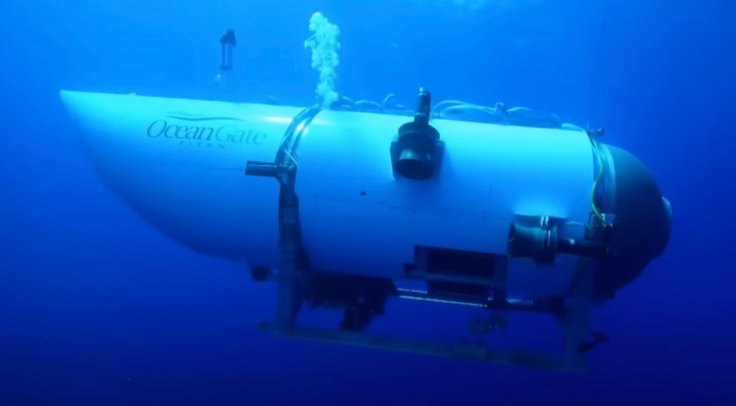Chances and hopes of finding the Titan, the Titanic-bound submersible, that went missing with five crew members on board, have grown after rescue groups reported "likely signs of life" and "banging sounds," according to reports. This comes as the Titanic sub is now left with just hours of oxygen to support the lives of the five aboard the vessel.
A Canadian aircraft taking part in the extensive search effort to find the missing Titanic tourists reported "banging" in the region where the submarine vanished at intervals of 30 minutes. The Daily Mail reported that the sounds of banging were also mentioned in emails written to the US Department of Homeland Security and obtained by Rolling Stone.
Hopes of Locating Sub Grow

"There is cause for hope," The Explorers Club President Richard Garriot de Cayeux wrote in a social media post on Tuesday night. "We have much greater confidence that 1) There is cause for hope, based on data from the field - we understand that likely signs of life have been detected at the site," he wrote in a statement.
The exact timing of the banging sounds remains uncertain, and there is no official confirmation or information regarding the finding of the crew that has been trapped in the depths of the Atlantic Ocean since their submersible set off on Sunday and subsequently lost communication with the surface, the outlet reported.
"RCC Halifax launched a P8, Poseidon, which has underwater detection capabilities from the air," the DHS memo on the banging sound read, "reported a contact in a position close to the distress position.

"The P8 heard banging sounds in the area every 30 minutes. Four hours later additional sonar was deployed and banging was still heard."
The document doesn't specify the reason or date of the banging.
Garriot de Cayeux added that the U.S. Coast Guard "precisely understands the experienced personnel and tech we can deeply," and "believes they are doing everything possible with all resources they have."

According to reports, the people who are believed to be trapped in the submarine are billionaire Hamish Harding, French explorer Paul-Henri Nargeolet, OceanGate CEO Stockton Rush, Shahzada Dawood (a 48-year-old UK-based board member of the Prince's Trust charity), and his son Sulaiman Dawood, 19.
Race Against Time
One of the five people on the submarine, Harding, is a founding member of the Board of Trustees for the Explorers Club. The group has stated that they have direct lines to Congress, the Coast Guard, Air Force, Navy, and the White House.

According to the Daily Mail, a DHS announcement also mentioned that "the Joint Rescue Coordination Centre is working to find an underwater remote-operated vehicle through partner organizations to possibly assist."
Efforts are currently underway to locate the OceanGate submersible, the Titan, which went missing after losing communication with the mothership while descending towards a shipwreck on Sunday morning.
Rear Admiral John Mauger, involved in coordinating the search operation, has indicated that there is a possibility that the submersible may be trapped or stuck.

"We don't have equipment onsite that can do a survey of the bottom," Mauger said on Tuesday.
"There is a lot of debris, so locating it will be difficult. Right now, we're focused on trying to locate it."
Royal Navy Rear Admiral Chris Parry has compared the depths of the Atlantic Ocean to the vastness of being in space. He drew a parallel between the challenging and unfamiliar nature of exploring the ocean's depths and the vastness and unknowns encountered in space exploration.
"It's utterly dark down there, and you have also got a lot of mud and other stuff getting swept up. You can only see about 20 feet in front of you with searchlights. There are very strong ocean currents which are pushing you along," said Perry.

In the event that the mini-submarine has lost power, leaving its five passengers without functioning propellers, lights, or heating, they would find themselves in complete darkness. The temperature inside the submersible would be approximately 3°C (37°F), as the ill-fated craft moves along the seabed.
"Where is it? Is it on the bottom, is it floating, is it mid-water? That is something that has not been determined yet," oceanographer and Titanic expert David Gallo said.
"The water is very deep – two miles plus. It's like a visit to another planet. It is a sunless, cold environment and high pressure," he added.
The main issue is that Titan can no longer transmit signals, making it almost impossible to locate the vessel. The last sonar 'ping' it was scheduled to send to the mothership Polar Prince was at 9.45 am on Sunday, an hour and 45 minutes into the dive when it was floating directly above the Titanic (radar and GPS are not functional underwater).

It has been reported that OceanGate Expeditions, the company responsible for organizing tours of the Titanic, took approximately eight hours before notifying the coastguard about the situation on Sunday.
The incident was reported to the US Coast Guard at 5:40 pm, while Canada's Coast Guard was alerted even later, at 9:13 pm. The delay in notifying the coastguard authorities has raised concerns and questions regarding the handling of the situation and the timeliness of the response.
Based on the estimated oxygen supply, the submarine is believed to have approximately 96 hours before the oxygen runs out. This means that rescue teams have until Thursday morning to locate the vessel and initiate a rescue operation.









